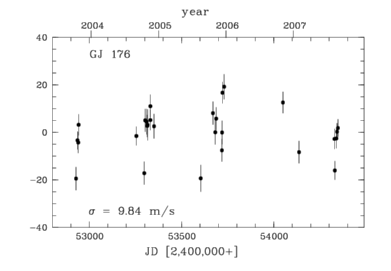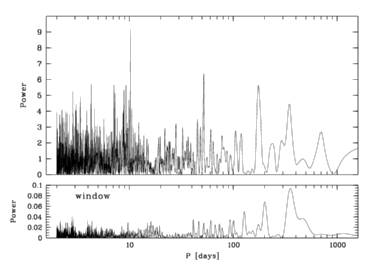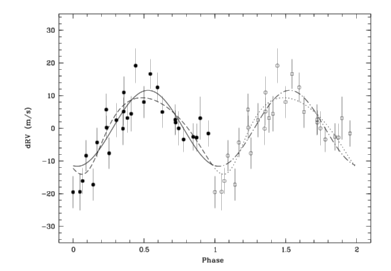An m sin i = 24 Earth Mass Planetary Companion to the nearby M dwarf GJ 176
UPDATE Sep.2008: Forveille et al. find a different solution for the GJ 176 system
(a Super-Earth planet combined with a stellar activity signal) using HARPS data! UPDATE
Their paper can be found here:
astro-ph/0809.0750
We detected a planetary companion with a minimum mass of
m sin i = 0.0771 M_Jup = 24.5 Earth masses to the nearby (d=9.4 pc) M2.5V star GJ 176.
The star was observed as part of our M dwarf planet search at the Hobby-Eberly Telescope (HET).
The detection is based on 5 years of high-precision differential radial velocity (RV) measurements
using the High-Resolution-Spectrograph (HRS). The orbital period of the planet is 10.24 d. GJ 176 thus
joins the small (but increasing) sample of M dwarfs hosting short-periodic planets with minimum masses in
the Neptune-mass range. Low mass planets could be relatively common around M dwarfs and the current
detections might represent the tip of a rocky planets population.

Time series of the HET radial velocity data for GJ 176. The total
scatter of ~10 m/s is twice as large as the average measurement
uncertainty of 4.7 m/s.
Click for larger image

Lomb-Scargle periodogram of the GJ 176 RV data. The upper panel shows the power
spectrum of the data and the lower panel displays the window function of our
observations. The peak at 10.2 days has a false-alarm-probability of 0.0004.
Click for larger image

Phase plot of the GJ 176 RV results shown along with the 2 possible orbits (circular and eccentric
solution) for the low mass planet. The data are repeated for
a second cycle (left side).
Click for larger image
Parameters of the planet and its orbit:
(circular solution:)
P = 10.237 ± 0.004 [days]
T periastron = 2454550.7 ± 0.39 [BJD]
K = 11.6 ± 1.6 [m/s]
e = 0.0 (fixed)
omega = 0.0 [deg] (fixed)
M sin i = 0.0771 ± 0.0122 [Jupiter] = 24.5 ± 3.9 [Earths]
a = 0.0727 ± 0.0007 [AU]
(eccentric solution:)
P = 10.237 ± 0.0038 [days]
T periastron = 2455037.8 ± 1.1 [BJD]
K = 11.7 ± 1.6 [m/s]
e = 0.232 ± 0.127
omega = 210.4 ± 32.5 [deg]
M sin i = 0.0757 ± 0.01 [Jupiter] = 24.1 ± 3.1 [Earths]
a = 0.0727 ± 0.0007 [AU]
Parameters of the host star:
GJ 176 = HD 285968
Spectral type = M2.5Ve
M = 0.49 ± 0.014 M [Sun]
[Fe/H] = -0.1 ± 0.2
d = 9.4 parsec (Hipparcos pi = 106 mas)
B - V = 1.51
Publication:
Endl M., Cochran W.D., Wittenmyer R. A., Boss, A.P. 2007, ApJ accepted
astro-ph/0709.0944
Acknowledgment: This work is supported by the National Aeronautics and
Space Administration under grant NNX07AL70G issued through the Origins of Solar Systems program.
Back to Planetary Systems
web-page by: Michael Endl


